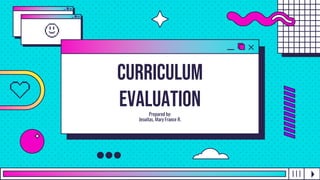
Curriculum Evaluation & Curriculum Improvement
- 1. CURRICULUM EVALUATION Prepared by: Jesuitas, Mary France R.
- 2. Learning objectives: To determine the reasons behind curriculum evaluations To discuss different models under curriculum evaluations To be familiar with various types of evaluations used for developing curriculum To explain levels of curriculum improvement and its approaches
- 3. To curriculum improvement Levels approches table of contents 01. 02. REASONS TYPES Models For curriculum evaluations Of curriculum evaluations Of curriculum evaluations 01. 02. 03. Of curriculum improvement CURRICULUM EVALUATION CURRICULUM IMPROVEMENT
- 5. ongoing process of collecting, analyzing, synthesizing, and interpreting information to aid in understanding what students know and can do. full range of information gathered in the school district to evaluate (make judgments about) student learning and program effectiveness in each content area. CURRICULUMEVALUATION
- 6. EFFECTIVE EDUCATIONAL PROGRAM ASSURANCE REASONS FOR EVALUATIONS FOR FEEDBACK AND IMPROVEMENT TEACHING EFFECTIVENESS TO UPDATE INSTRUCTIONAL MATERIALS
- 7. Reasons for evaluations Curriculum evaluation establishes: Specific strengths and weaknesses of a curriculum and its implementation; Critical information for strategic changes and policy decisions; Inputs needed for improved learning and teaching; Indicators for monitoring.
- 9. occurs during the course of curriculum development allows you to get feedback on a consistent basis FORMATIVE done at the end of a school year or through standardized assessment testing measure curricular success by reviewing the outcomes SUMMATIVE TYPES OF EVALUATIONS
- 10. 1. Bureaucratic evaluation 2. Autocratic evaluation 3. Democratic evaluation 4. Norm-referenced evaluation 5. Criterion-referenced evaluation Gatawa (1990) identified fivecurriculum evaluationapproaches TYPES OF EVALUATIONS
- 12. EVALUATION MODELS 5 AREAS Focus Approach Content Process Structure Curriculum models are used to write curriculum guides to determine specific aspects of teaching.
- 13. One of the earliest curriculum evaluation models by Ralph Tyler (1950) Key Emphasis: Instructional Objective Purpose: To measure students progress towards objectives img.jpg Tyler’s objective-centered models
- 14. img.jpg Tyler’s objective-centered models Advantages Disadvantages Simplicity Focuses attention on curricular strengths and weaknesses Emphasizes the importance of assessment, analysis, and improvement. Does not suggest how the objectives themselves should be evaluated. Does not provide standards Include assessment as a final steps, rather than an ongoing process.
- 15. img.jpg Stufflebeam’scipp Model The CIPP model of evaluation concentrates on: Context of the programme Input into the programme Process within the programme Product of the programme
- 16. img.jpg Stufflebeam’s cipp Model Key Emphasis: Decision-making Purpose: To facilitate rational and continuing decision-making Strengths: a) Sensitive to feedback b) Rational decision making among alternatives Evaluation: Identify potential alternatives, set up activity quality control systems
- 18. Also known as COUNTENANCE MODEL ANTECEDENTS – Conditions prior ro curriculum evaluation TRANSACTIONS – Interaction that occurs OUTCOMES img.jpg Stake’s responsive model
- 19. Key Emphasis: Description and judgement of data Purpose: To report the ways different people see curriculum 1. Responds to audience needs for information 2. Orients more toward program activities than results 3. Presents all audience view points(multi perspective) img.jpg Stake’s responsive model
- 20. Limitations: 1. Stirs up value Conflicts 2. Ignores causes img.jpg Stake’s responsive model
- 21. img.jpg Kirkpatrick’s model Each successive evaluation level is built on information provided by the lower level Reaction Learning Behavior Result
- 24. APPROACHES TO CURRICULUM According to Ornstein and Hunkins (1993) the main curriculum approaches are: 1. Behavioral Approach - concerned with observable and measurable aspects of human behavior. 2. Managerial Approach - Concerned on organization and restructures the schools 3. Systems Approach - basically a process of problem solving 4. Humanist Approach – The learners are the prime consideration.
- 25. APPROACHES TO CURRICULUM Other approaches are: 1. The Four-step Approach - selection of objectives, selection of learning experiences, organization of learning experiences and evaluation. 2. The Five-step Approach - additional step to emphasize situational analysis 3. The Seven-step Approach – Proposed by Hilda Taba.